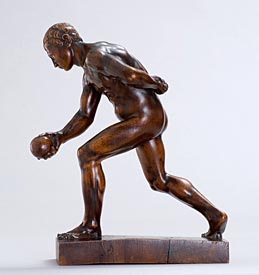Stellar Collection of Renaissance Sculpture Promised to National Gallery of Art by Robert H. Smith
 Leonard Kern, German (1588 - 1662), Bowler, 1617-1620
Leonard Kern, German (1588 - 1662), Bowler, 1617-1620Photograph courtesy of the Robert E. Smith collection
The National Gallery of Art in Washington, D.C., recently announced that the Robert H. Smith Collection, one of the most important private collections of Renaissance bronze sculpture, has been promised to the Gallery by its owner, Gallery president emeritus Robert H. Smith. This important collection encapsulates the history of Renaissance bronze sculpture in Europe at a superior level, and includes outstanding carvings in ivory and boxwood.
"Robert Smith's connoisseurship and generosity will bring our bronze collection to the level of the great princely collections formed over centuries in Europe," says Earl A. Powell III, director, National Gallery of Art. "The ivories will enhance our holdings in a medium we have only begun to collect in the past decade. Boxwood is a completely new medium for us; like ivory, it lends itself to fine and delicate carving."
Assembled over three decades, the collection consists of 67 bronzes, five boxwood carvings, and three ivories, and is still growing. Of these, 47 bronzes and all of the boxwood and ivories were on view in the exhibition Bronze and Boxwood: Renaissance Masterpieces from the Robert H. Smith Collection through May 4. The collection has greatly expanded since part of it was on view in 2002 for the opening of the ground floor Sculpture Galleries at the National Gallery of Art.
The Robert H. Smith Collection is comprised of exceptionally fine works by major contemporaries and successors of Michelangelo. Among these are four masterpieces acquired since 2002: a superb cast of Giovanni Bologna's Cesarini Venus (late-16th or early 17th century), which was once in the French royal collection; the finest and earliest version of the same sculptor's famous Birdcatcher (late-16th century); the Seated Nymph (1503), one of the most exquisite bronzes made in the early 16th century by the celebrated goldsmith and sculptor Antico, whose real name was Pier Jacopo Alari-Bonacolsi; and Giovanni Francesco Susini's David with the Head of Goliath (c. 1625-1630), which, like many of the works in the collection, invites admiration from any angle. Giovanni Francesco Susini is the nephew of Giovanni Bologna's bronze caster, Antonio Susini.
The bronze sculptures are complemented by boxwood and ivory carvings, including the largest grouping of works outside Germany by the sculptor Leonhard Kern, one of the greatest masters in these media. A virtuoso carver, he cut his figures out of a single block of wood or ivory. Works in boxwood were often tinted to resemble the colors of bronze sculpture, while the gleam of ivory evoked the purity of white marble on a miniature scale.
Also in this Issue:
- Public Sculpture Series Bronzes Notable TV Icons
- Yoshitomo Saito: The Bronze Weaver
- The Patriotic Roots of Valley Bronze of Oregon
- The Not-So-Lost Art of Lost Wax Casting
- Stellar Collection of Renaissance Sculpture Promised to National Gallery of Art by Robert H. Smith
